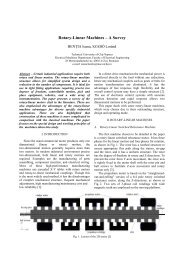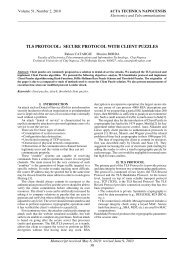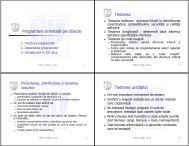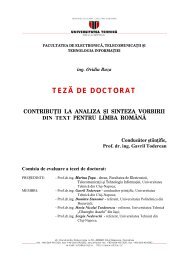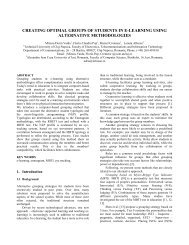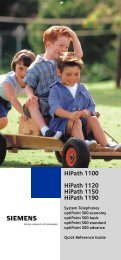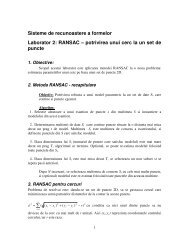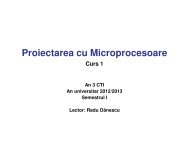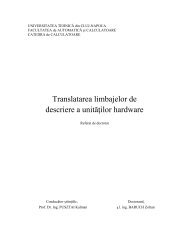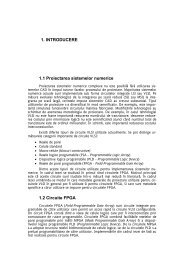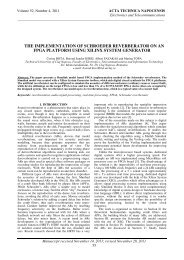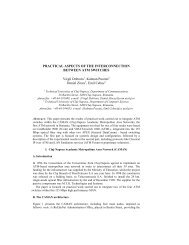LTE Emulator
LTE Emulator
LTE Emulator
You also want an ePaper? Increase the reach of your titles
YUMPU automatically turns print PDFs into web optimized ePapers that Google loves.
TUCN – Data Transmission Laboratory<br />
The second group of parameters is also considered in the emulation process, i.e. the ones<br />
referring to the cell dimension (the cell is assumed circular, with a given radius), type of cell<br />
(urban/rural, small/large), the noise and/or interference distribution, mobile speed and its motion<br />
law and characteristics of the base station transceiver (carrier frequency, transmission power,<br />
height of the antenna). The value of the SNR0 is computed by using these parameters and tables<br />
with bit error and delay distributions are selected, according to the SNR0 value, out of a group of<br />
tables corresponding to the carrier frequency, multipath propagation profile and the cell carrier<br />
load.<br />
The speed of the user can be set both in the simulation and emulation processes. The two<br />
speeds do not have to be equal, if the synchronization/equalization operations are considered to<br />
be ideal, because the speed does not affect the probability density functions, if the simulation is<br />
performed within a sufficiently large time interval. Therefore, different values of the mobile’s<br />
speed do not require tables with different statistics. The velocity of the user is used in the<br />
simulation process, as well as in the emulation one, for computing the coherence time of the<br />
channel [Rap01] [Skl97], which has to be greater than the TTI interval. The channel<br />
characteristics are considered constant within the coherence time interval and, during this<br />
interval, only a single value is employed both for the instantaneous rate (number of bits/TTI) and<br />
the number of errors/TTI (the error distribution can vary within the data packet).<br />
3.1. Functional blocks of the emulator. Parameters of the functional blocks<br />
6<br />
3.1.1. The signal to noise ratio computation block<br />
This block has the purpose of reading the parameters of the cell (the geometry of the cell), of<br />
the base station transceiver and of the user’s mobility and to compute the value of the SNR0.<br />
Meanwhile the block provides the display of the main user’s trajectory within the cell. The<br />
parameters that are processed by this block, divided into 4 groups, are the following (see also fig.<br />
3.2.):<br />
o cell radius (circular cell) expressed in km;<br />
o cell dimension: small cell (radius ≤1km) and large cell (radius > 1km);<br />
o cell type: urban, suburban, rural;<br />
Note: the last two parameters select the formulae used for the computation of the<br />
attenuation, referred to the base station (center of the cell), i.e. the formulae that are<br />
used to compute the large scale fading, which depends on the cell-type.<br />
o channel carrier frequency, expressed in MHz;<br />
o transmission power of the base station, expressed in dBm;<br />
o noise power expressed in dBm;<br />
Note: in this emulator version, the noise spectral power density is considered<br />
constant in the entire cell.<br />
o height of the antenna of the base station transceiver, expressed in m.<br />
Note: height of the user’s antenna is considered constant and equal to 1.5m;<br />
o speed of the user, expressed in km/h;<br />
Note: the speed of the mobile must be chosen such that the coherence time of the<br />
mobile radio channel is greater or equal to the duration of the transport frame. The<br />
computation of the coherence time is made according to relation (2). In the present<br />
version, the emulator does not check the fulfillment of this condition; this task is to<br />
be accomplished by the user, when setting the emulation parameters.<br />
o the mobile’s motion law. It involves the function that describes the position of the<br />
mobile in time, within the cell, as a function of the cell’s dimension and the mobile



